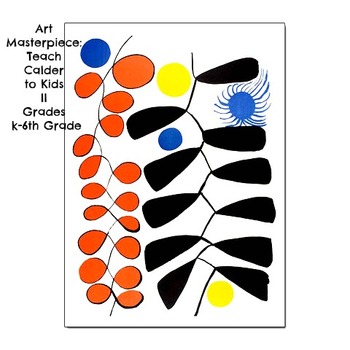Calder Art Lesson Spiral Magnitif History Lesson and Project
The Gifted Learner
1.6k Followers
Grade Levels
K - 4th
Subjects
Resource Type
Standards
CCSSK.MD.A.2
CCSS2.MD.A.1
CCSSK.G.A.1
CCSSK.G.A.2
CCSSK.G.B.4
Formats Included
- PDF
Pages
20 pages
The Gifted Learner
1.6k Followers
Also included in
- Attention Montessori and Kindergarten Teachers! Are you looking for an engaging and creative way to teach your students about renowned artists Gustav Klimt, Alexander Calder, and Hundertwasser? Look no further than our art lessons!Our lesson plan offers 5 unique ways to use this product and teach abPrice $6.50Original Price $9.00Save $2.50
Description
This lesson is an art history study of Alexander Calder which includes information about the artist and a detailed art lesson on how to create the painting "Spiral Magnitif"
What teachers are saying:
- Great addition to our study of artists.
- I enjoyed making the example, myself, and my students will have fun with this art activity.
What you will find inside the lesson:
Teacher prompts for you to read as you give the lesson making it EASY to teach!
- Glossary of art terms
- Brief discussion of each topic that is simple and easy to comprehend
- Questions to ask the students about the art
- Step by step DETAILED instructions for an art project with FULL COLOR pictures.
- INSTRUCTIONS ON HOW TO CONFORM THIS LESSON TO COMMON CORE STANDARDS
- Art work to show as examples
- Comprehension questions Worksheet for you to extend the learning that feature key facts about each art project
- Word search and/or coloring page for fast finishers
- Worksheet where students have the opportunity to give you feedback about the projects
Make sure to click the GREEN STAR near my store name so that you can stay in touch with my store. I create new lessons every week.
Total Pages
20 pages
Answer Key
N/A
Teaching Duration
30 minutes
Report this resource to TPT
Reported resources will be reviewed by our team. Report this resource to let us know if this resource violates TPT’s content guidelines.
Standards
to see state-specific standards (only available in the US).
CCSSK.MD.A.2
Directly compare two objects with a measurable attribute in common, to see which object has “more of”/“less of” the attribute, and describe the difference. For example, directly compare the heights of two children and describe one child as taller/shorter.
CCSS2.MD.A.1
Measure the length of an object by selecting and using appropriate tools such as rulers, yardsticks, meter sticks, and measuring tapes.
CCSSK.G.A.1
Describe objects in the environment using names of shapes, and describe the relative positions of these objects using terms such as above, below, beside, in front of, behind, and next to.
CCSSK.G.A.2
Correctly name shapes regardless of their orientations or overall size.
CCSSK.G.B.4
Analyze and compare two- and three-dimensional shapes, in different sizes and orientations, using informal language to describe their similarities, differences, parts (e.g., number of sides and vertices/“corners”) and other attributes (e.g., having sides of equal length).



